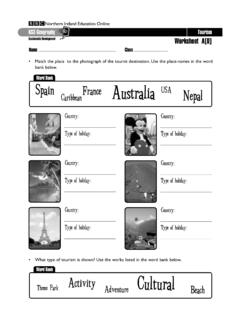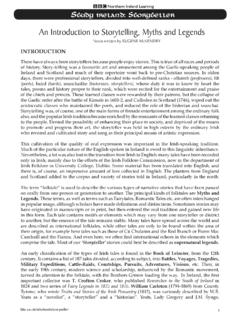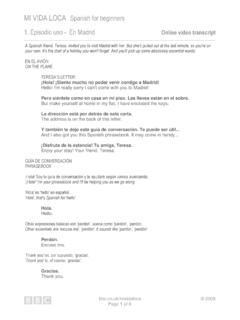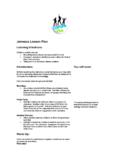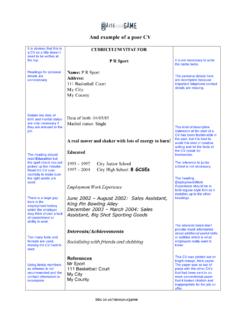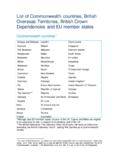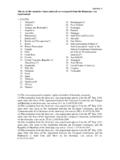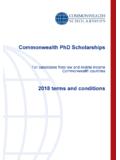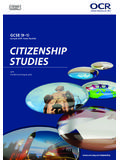Transcription of ETHNIC MINORITIES Who Lives Here? - BBC - Home
1 TEACHER'S NOTES KS3/KS4. ETHNIC MINORITIES Who Lives here ? MINORITY ETHNIC GROUPS IN NORTHERN IRELAND. In recent years there has been a growing interest in ETHNIC minority populations in Northern Ireland. The arrival of people from a variety of ETHNIC backgrounds has been noted in places such as Dungannon as well as in parts of Belfast. The appearance of racially motivated crime has also been widely covered in the media. The actual numbers of people from minority ETHNIC groups who live in Northern Ireland are very low. Furthermore, the demographic growth that has taken place is not solely due to immigration but is also the result of a small expansion among already established ETHNIC minority groups.
2 It is dif cult to calculate the rate at which ETHNIC minority groups have grown, as the data needed to make such an assessment has not been available. However, we can determine the size of the ETHNIC minority population from the government census1 which is undertaken every ten years. The last census was in 2001 and for the rst time questions were included which asked people to identify which ETHNIC group they belonged to. ETHNIC groups are determined in the NI Census of Population 20012 as: collections of people who identify with one another on the basis of a boundary that distinguishes them from other groups;. a boundary may take any of a number of forms (racial, cultural, linguistic, economic, religious, political).
3 A common misunderstanding is that ETHNIC groups are made up of people who are not White. But a person's ethnicity is never simply based upon the colour of their skin. Black people, for example, can be from a Caribbean or African ETHNIC group. Indeed it would be possible to divide Black Africans into a whole series of ETHNIC groups given their various languages, customs, religious beliefs and national identities. Indians, Pakistanis and Bangladeshis can also come from different religious and linguistic groups. Another characteristic of ETHNIC groups is continuity in time, that is they have a history and a future as a people.
4 This is achieved through the consistent use of a common language, institutions and traditions over many generations. It is important to consider these criteria if we are to distinguish them from a group of individuals who share a common characteristic, such as ancestry. It is also important to remember that a person may choose to hold, for example, a Chinese based ETHNIC identity even though he/she was born in Northern Ireland and has characteristics and beliefs similar to the majority of people who live here . Everyone in Northern Ireland is part of an ETHNIC group. People who consider themselves to be _____. 1 The aim of the census is to nd out how the population has changed.
5 The census helps in the planning of Northern Ireland's future and ensures that policymaking is linked closely to the province's population pro le. 2 Northern Ireland Statistics & Research Agency: Northern Ireland Census Access 1. ETHNIC MINORITIES . RACISM Who Lives here ? Irish or british often express signs of dissimilarity in their culture, religious and political beliefs and many people consider these differences as being ethnically different. However, in order to unravel some of the complexities of ethnicity we now examine the minority ETHNIC communities who live in Northern Ireland. As shown in ETHNIC Map 1 (see Who Lives here ?)
6 Section of website) and Table 1 (see below). minority ETHNIC groups are a mere of Northern Ireland's population. This is less than one in every hundred people. Northern Ireland has one of the smallest ETHNIC minority populations within the European Union. Down through the centuries the UK has been a haven for refugees. The in ux of Protestant and Jewish refugees was commonplace between the 17th and 19th centuries. More recently, it has been political refugees eeing war and persecution as well as economic refugees leaving lesser developed countries for a better life in a rst world economy. Many of these people come to the UK after acquiring work permits which allow them to stay for a de ned period during which they must remain in employment.
7 In more recent times there has been a very signi cant growth in immigration into the Republic of Ireland due to economic growth, increased af uence and labour shortages. There have been a series of major migrations into the United Kingdom since the 1950s. These immigrants tended to come from countries that formed the british Commonwealth. The rst major immigration in the 1950s came about due to labour shortages in the UK which had been created by World War II and the re-building of the post-war economy. Table 1: Minority ETHNIC groups (%) in parliamentary constituencies in 2001. Parliamentary Total Total ETHNIC constituency population ETHNIC minority minority members members (%).
8 Belfast East 79269 797 Belfast North 86064 644 Belfast South 94978 2500 Belfast West 87613 643 East Antrim 84073 713 East Londonderry 88736 763 Fermanagh & 91122 538 South Tyrone Foyle 105078 962 Lagan Valley 101704 779 Mid Ulster 86507 541 Newry & Armagh 100956 641 North Antrim 101440 566 North Down 85998 744 South Antrim 99819 797 South Down 104660 517 Strangford 98141 757 Upper Bann 102955 936 West Tyrone 86210 514 Totals 1685323 14352 Source: census of population, 2001. Unlike Great Britain and the Republic of Ireland, Northern Ireland has never received a signi cant in ow of people. This is due to a range of reasons which include: Physical remoteness means that Northern Ireland is largely unaffected 2.
9 ETHNIC MINORITIES . RACISM Who Lives here ? by the current ow of immigrants and ETHNIC groups within Europe;. Northern Ireland is one of the poorest regions within the United Kingdom and few people migrate here due to a lack of jobs or business opportunities;. Continued political instability may still discourage people from coming to live here . Despite not attracting many immigrants there have been Indian, Bangladeshi and Pakistani populations in Northern Ireland for over 60 years. The rst Indian retail business began in Londonderry in 1943. Many of these original immigrants came to Northern Ireland via internal migration within the UK.
10 These three communities are closely tied to the retailing and restaurant business as well as other professions, notably health. The majority of Chinese immigrants originally came from Hong Kong, a british colony until 1997. Like the communities from South Asia they usually came to Northern Ireland after living in other parts of the UK. The rst recorded Chinese restaurant (The Peacock) opened in 1962 in Belfast. The restaurant trade has become a major factor in the growth of the Chinese community. Around 60% of Chinese people living in Northern Ireland were born here . Irish Travellers represent the third largest group in Northern Ireland.

